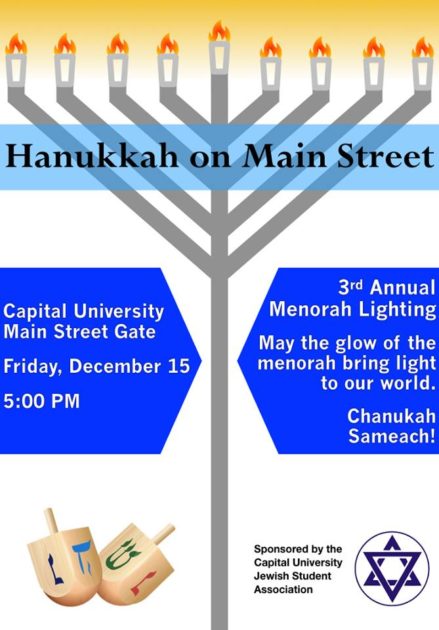Christmas gets a lot of recognition, with its capitalist extremities and overwhelming traditions. However, it is not the only holiday for spending time with family and getting in touch with one’s roots.
Hanukkah, or Chanukah, is a Jewish holiday that commemorates the re-dedication during the second century B.C. of the second temple in Jerusalem.
“Hanukkah, which means ‘dedication’ in Hebrew, begins on the 25th of Kislev on the Hebrew calendar and usually falls in November or December,” Spencer Delk, president of Capital Jewish Student Association, said.
Delk said the holiday, which is often called the Festival of Lights, is celebrated with the lighting of the menorah, and with traditional foods, games and gifts.
“According to the Talmud, one of Judaism’s most central texts, Judah Maccabee and the other Jews who took part in the re-dedication of the Second Temple witnessed what they believed to be a miracle,” Delk said.
Although there was only enough olive oil to keep the menorah’s candles burning for one day, the flames continued on for eight nights, which left enough time for Maccabee and the others to find a fresh supply. This event inspired the sages to proclaim the yearly festival.
In terms of traditions, Delk wrote about the lighting of the menorah and the dreidel game.
“With the lighting of the menorah, there are eight candles to it, and a candle is lit each day of Hanukkah,” Delk said. “On the first day you light the central candle, and then from there the rightmost candle is lit.”
Each day, a new candle is lit until the whole menorah is illuminated.
The dreidel game is a traditional Hanukkah game where a dreidel, or top, is spun, and a corresponding word signifies an action. The game is usually played with a pot of coins (or sometimes gelt, chocolate coins received during Hanukkah). Each player begins with 10-15 coins.
“The four actions are nun or ‘nothing’ meaning nothing happens, gimel or ‘all’ meaning that the person takes everything in the pot, hey or ‘half’ meaning that the person takes half the pot, and shin or ‘put in’ where the person puts in a coin to the pot,” Delk said.
Traditional foods include potato latkes (or pancakes) and rugelach (or rugelesh), a doughy dessert often filled with components such as raisins, fruit preservatives, cinnamon, or chocolate.
“The holiday tradition of giving and receiving gifts is also present in Hanukkah, where people do have some choice in giving eight small gifts, one for each night of Hanukkah (which is the typical tradition) or one big gift for the children,” Delk said.
Delk finds it important that he continue celebrating Hanukkah and partaking in Jewish traditions.
“To me, being someone who is Jewish through birthright and am culturally Jewish, having the idea of the Jewish tradition of Hanukkah survive just like my family celebrated in the past in the biggest part for me,” Delk said. “I am proud of my Jewish heritage, and to demonstrate that I want to celebrate the holidays and try to live in a way I feel will make my family of past generations proud.”
This year, Hanukkah runs from the evening of Dec. 12 to the evening of Dec. 20. At 5:00 p.m. on Dec. 15 on Renner Lawn, the Jewish Student Association will be hosting Hanukkah on Main Street, its third annual menorah lighting.



